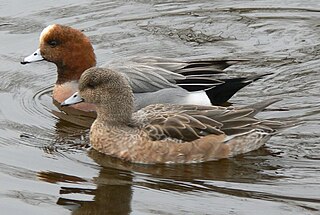
The Eurasian wigeon or European wigeon, also known as the widgeon or the wigeon is one of three species of wigeon in the dabbling duck genus Mareca. It is common and widespread within its Palearctic range.

The Caspian tern is a species of tern, with a subcosmopolitan but scattered distribution. Despite its extensive range, it is monotypic of its genus, and has no accepted subspecies. The genus name is from Ancient Greek hudros, "water", and Latin progne, "swallow". The specific caspia is from Latin and, like the English name, refers to the Caspian Sea.
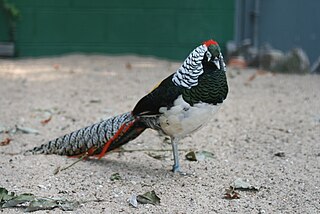
Lady Amherst's pheasant is a bird of the order Galliformes and the family Phasianidae. The genus name is from Ancient Greek khrusolophos, "with golden crest". The English name and amherstiae commemorates Sarah Amherst, who was responsible for sending the first specimen of the bird to London in 1828. Lady Amherst's pheasant is evaluated as Least Concern on the IUCN Red List of Threatened Species.
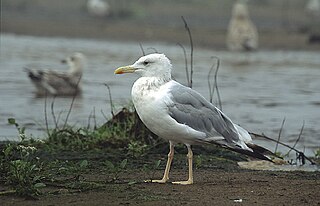
The Caspian gull is a large gull and a member of the herring and lesser black-backed gull complex. The scientific name is from Latin. Larus appears to have referred to a gull or other large seabird, and cachinnans means 'laughing', from cachinnare 'to laugh'.

The blood pheasant, also known as blood partridge, is the only species in genus Ithaginis and tribe Ithaginini of the pheasant family. It is a relatively small, short-tailed pheasant that is widespread and is fairly common in eastern Himalayas, ranging across India, Nepal, Bhutan, China, and northern Myanmar. Since the trend of the population appears to be slowly decreasing, the species has been evaluated as of least concern on the IUCN Red List in 2009.
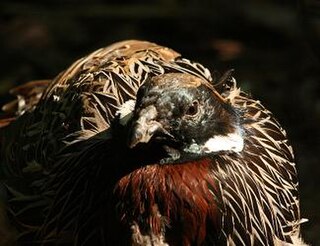
The koklass pheasant is a species of gamebird, being closely related to progenitive grouse that lived during the Miocene. They are distantly related to pheasants and are most closely related to grouse and turkeys. Koklass are the only species in the monotypic genus Pucrasia and the tribe Pucrasiini. Both the words koklass and pucrasia have been onomatopœically derived from the bird's territorial call. Koklass are boreal adapted species which separate into three distinct species groups. They are one of the few gamebirds that regularly fly uphill and are capable of sustained flights of many miles. They are monogamous with a slight tendency toward social polyandry. Both parents rear the chicks. Koklass are largely vegetarian for much of the year consuming pine nuts, pine shoots, bamboo shoots and seeds. They are highly insectivorous during the warmer months that coincide with nesting and chick-rearing. During this phase of their life cycle they live almost exclusively on ants but also are documented consuming catkins, pollen and fruit.

The snowcocks or snowfowl are a group of bird species in the genus Tetraogallus of the pheasant family, Phasianidae. They are ground-nesting birds that breed in the mountain ranges of southern Eurasia from the Caucasus to the Himalayas and western China. Some of the species have been introduced into the United States. Snowcocks feed mainly on plant material.

The Caucasian snowcock is a snowcock in the pheasant family Phasianidae of the order Galliformes, gallinaceous birds.

The silver pheasant is a species of pheasant found in forests, mainly in mountains, of mainland Southeast Asia and eastern and southern China, with an introduced population on Victoria Island in Nahuel Huapi Lake, Neuquén, Argentina. The male is black and white, while the female is mainly brown. Both sexes have a bare red face and red legs. It is common in aviculture, and overall also remains common in the wild, but some of its subspecies are rare and threatened.

The Tibetan partridge is a gamebird in the pheasant family Phasianidae of the order Galliformes. They are found widely across the Tibetan Plateau and have some variations in plumage across populations. They forage on the ground in the sparsely vegetated high altitude regions, moving in pairs during the summer and in larger groups during the non-breeding season. Neither males nor females have spurs on their legs.

The snow partridge is a gamebird in the pheasant family Phasianidae found widely distributed across the high-altitude Himalayan regions of India, Pakistan, Nepal and China. It is the only species within its genus, and within the tribe Lerwini, and is thought to be the most basal member of the subfamily Phasianinae. The species is found in alpine pastures and open hillside above the treeline but not in as bare rocky terrain as the Himalayan snowcock and is not as wary as that species. Males and females look similar in plumage but males have a spur on their tarsus.

The kalij pheasant is a pheasant found in forests and thickets, especially in the Himalayan foothills, from Pakistan to western Thailand. Males are rather variable depending on the subspecies involved, but all have at least partially glossy bluish-black plumage, while females are overall brownish. Both sexes have a bare red face and greyish legs. It is generally common and widespread, though three of its eastern subspecies are considered threatened and L. l. moffitti is virtually unknown in the wild. On 21 October 2021, the Government of Jammu and Kashmir declared Kalij Pheasant as bird of the Union Territory of Jammu and Kashmir.

The western tragopan or western horned tragopan is a medium-sized brightly plumed pheasant found along the Himalayas from north-eastern districts of Khyber Pakhtunkhwa province in northern Pakistan in the west to Uttarakhand within India to the east. The species is highly endangered and globally threatened.
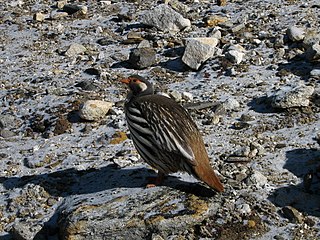
The Tibetan snowcock is a bird in the pheasant family Phasianidae of the order Galliformes, gallinaceous birds. This species is found in high-altitude regions of the Western Himalayas and the Tibetan Plateau, where it overlaps in part with the larger Himalayan snowcock. The head is greyish and there is a white crescent patch behind the eye and underside is white with black stripes. In flight the secondaries show a broad white trailing edge.

The Chinese monal or Chinese impeyan is a pheasant. This monal is restricted to mountains of central China. The plumage is highly iridescent. The male has a large drooping purple crest, a metallic green head, blue bare skin around the eyes, a reddish gold mantle, bluish green feathers and black underparts. The female is dark brown with white on its throat.

The brown eared pheasant is a large, 96– to 100-cm-long, dark brown pheasant endemic to the mountain forests of northeastern China. The species was first described by Robert Swinhoe in 1863. It has stiff white ear coverts behind the eyes, which look like a moustache. The crown is black with red bare facial skin and its tail of 22 elongated, white feathers is curved, loose and dark-tipped. Both sexes are similar in plumage.

The Himalayan snowcock is a snowcock in the pheasant family Phasianidae found across the Himalayan ranges and parts of the adjoining Pamir range of Asia. It is found on alpine pastures and on steep rocky cliffs where they will dive down the hill slopes to escape. It overlaps with the slightly smaller Tibetan snowcock in parts of its wide range. The populations from different areas show variations in the colouration and about five subspecies have been designated. They were introduced in the mountains of Nevada in the United States in the 1960s and a wild population has established in the Ruby Mountains.

The red-capped plover, also known as the red-capped dotterel, is a small species of plover.

The Altai snowcock is a species of bird in the family Phasianidae. It is found in western Mongolia and adjacent areas of China, Kazakhstan and Russia. Its natural habitat is boreal forests.

Perdicinae is a polyphyletic former subfamily of birds in the pheasant family, Phasianidae, regrouping the partridges, Old World quails, and francolins. Although this subfamily was considered monophyletic and separated from the pheasants, tragopans, junglefowls, and peafowls (Phasianinae) till the early 1990s, molecular phylogenies have shown that these two subfamilies actually constitute only one lineage. For example, some partridges are more closely affiliated to pheasants, whereas Old World quails and partridges from the Alectoris genus are closer to junglefowls. Due to this, the subfamily Perdicinae is no longer recognized by the International Ornithological Congress, with the species being split among 3 subfamilies.





















